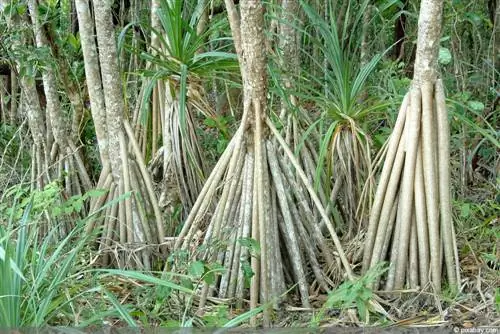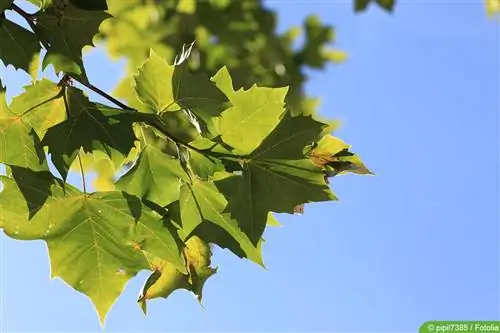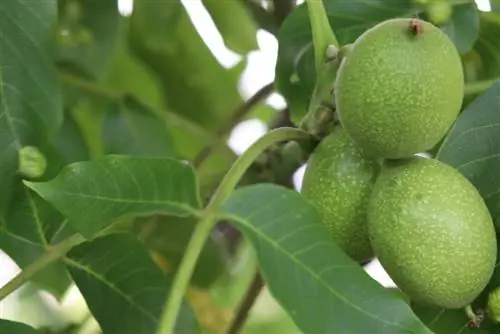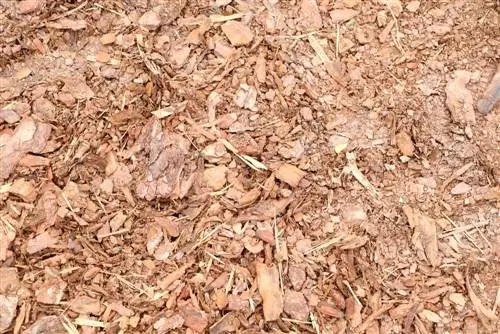- Author admin [email protected].
- Public 2023-12-17 03:39.
- Last modified 2025-01-24 12:45.
Mangrove trees thrive where living conditions are deadly for common tree species: under scorching sun, with roots in oxygen-deficient and unstable mud, and often submerged in s alty seawater. They are exposed to the constant changing of the tides and provide valuable habitats for hundreds of species of terrestrial and marine life. Mangrove forests line the coasts of tropical regions and protect against devastating floods.
What are mangroves?
“The” mangrove tree does not exist, because the term “mangrove” refers to tropical coastal forests consisting of various tree and shrub species. There are around 70 different evergreen species of mangrove trees worldwide, many of which do not even belong to the same plant families. But they have one thing in common: they thrive in extreme living conditions that are deadly for most other trees:
- high s alt concentrations
- muddy, flooded and unstable ground
- in the area of influence of strong tidal currents
The shrubs and trees have adapted perfectly to these changeable conditions by developing special physiological processes and structures.
Nevertheless, it is a delicate ecosystem whose development and continued existence is at great risk from human intervention.
Adaptation to an extreme habitat
Without their characteristic survival strategies, mangroves would have no chance in their native habitat. The different species have developed strategies to compensate for the high s alt concentrations. Basically, the trees can be divided into two groups: The first has developed glands that enable the s alt absorbed by the roots to be excreted through the leaves. The second group, on the other hand, stores the s alt in the succulent leaves, dilutes the concentration through increased water absorption and finally sheds the leaves.
Roots
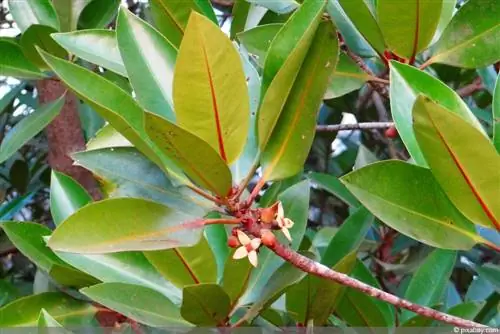
The roots of conventional trees require permeable soil that supplies the underground system with sufficient oxygen. Mangrove roots, on the other hand, cannot “breathe” because the subsoil contains no or extremely little oxygen. Regular flooding with sea or brackish water (a mixture of s alt and fresh water) does the rest in this regard. Special respiratory roots still enable the tree roots to absorb oxygen by allowing water-impermeable lenticels, the finest root pores, to filter out oxygen during low tide. This is consumed during the subsequent flooding, during which the plant cannot actively breathe.
Reproduction
The third problem is the unstable ground, which actually makes it impossible to anchor firmly. In addition, the constant tidal movements also threaten to wash away the trees. Special stilt roots support the tree roots and ensure that they can withstand constant mechanical stress. Many mangrove species ensure their reproduction under these conditions by allowing their seeds to germinate on the mother tree - and the buoyant seedling can float on the water until it finds a suitable location to root. In this case, the formation of roots and leaves occurs extremely quickly.
Occurrence and distribution
Mangroves thrive in warm and rainy tropical coastal regions and are found primarily along the Central and South American, African, Indian and Southeast Asian sea coasts. Since they rely on calm water within the tidal currents, the typical mangrove forests form especially in the mouths of large rivers, in the sea behind coral reefs and in bays.
The trees only thrive in tropical regions with water temperatures of more than 20 degrees Celsius all year round, and the climate should remain the same all year round. The warmth of the air, on the other hand, is not crucial for the spread and establishment of mangroves.
Ecology and economic importance
Mangrove forests form a unique, very sensitive ecosystem that offers a protected habitat for numerous land and marine animals. Hundreds of species of fish, reptiles, amphibians, molluscs and crustaceans have their breeding grounds here, which the coastal inhabitants also take advantage of: People who traditionally make their living from fishing prefer to hunt in the mangrove forests. The upper floors of the trees, on the other hand, are reserved for typical land dwellers such as birds and reptiles - such as snakes. If the mangroves are cut down, the species adapted to this ecosystem lose their habitat and also disappear.
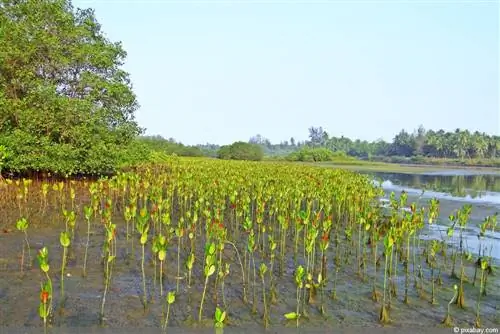
Furthermore, the mangroves, some of which are huge, protect the coastal regions, stabilize the soil and prevent soil erosion. The forests also stop severe flooding in coastal areas, especially during the rainy seasons. The population also uses the mangrove wood as fuel and for building houses. Last but not least, plants with edible fruits and valuable medicinal plants thrive here.
Destruction of mangrove forests
Mangrove forests have been cut down on a large scale for several decades - for example in order to be able to build sought-after properties directly on the beachfront properties. Furthermore, it is used for the cultivation of shrimps or prawns, as a result of which the mangroves abused for this purpose die off due to contamination by chemicals and drugs. The land is then contaminated for decades and cannot be reforested again.
In some countries - such as Thailand - around a fifth of mangrove destruction is due to industrial shrimp farming. The effects are clearly visible: Not only are the returns from coastal fishing declining sharply, storm surges and other floods hit the coasts unhindered and cause thousands of deaths. Some countries such as Vietnam, Thailand and Malaysia are now trying to counteract this and are increasingly promoting reforestation projects.
The most common mangrove species
Mangrove trees do not form a separate genus, but belong to different plant families assigned to the angiosperm plants (Magnoliophyta).
Red Mangrove (Rhizophora mangle)
This mangrove tree is probably the most famous. It is commonly found along the American coast between Florida and Brazil and in West Africa. This very dominant species even displaces other mangroves and is extremely robust and adaptable.
Tip:
If you want to cultivate mangroves as a houseplant or in an aquarium, you should try this comparatively easy-to-cultivate species. Under appropriate conditions, Rhizophora mangle also shows dwarfism and remains attractively small.
Black Mangrove (Avicennia germinans)
This type of mangrove, which belongs to the acanthus family (Acanthaceae), often forms large forests along the American and West African coasts together with the red and white mangroves.
Oriental Mangrove (Bruguiera gymnorhiza)
Sometimes incorrectly referred to as the “Caribbean mangrove,” this species is found exclusively in West Africa, Asia, and Australia and Oceania. It owes its name to its original distribution area in the Middle East, where it has been extinct for several decades.
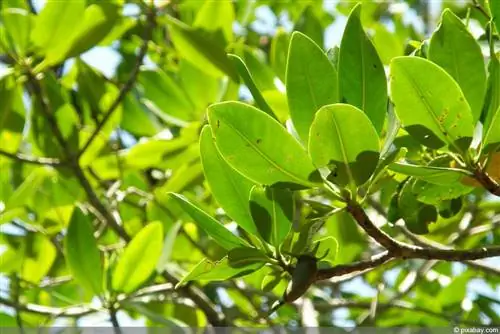
Styled Mangrove (Rhizophora stylosa)
Closely related to the red mangrove, this species occurs primarily along the Indian and Pacific coasts from India to Samoa. Rhizophora stylosa owes its name to the pronounced stilt roots, which ensure stability in muddy ground.
White Mangrove (Laguncularia racemosa)
The white mangrove is the only type of mangrove that belongs to the plant family Combretaceae. It is native to the American and West African coasts.
Gray Mangrove (Avicennia marina)
This mangrove is also sometimes called the “white mangrove,” but is native to the east coast of Africa and along the sea coasts of Asia and Australia. It has the largest distribution area of all mangrove species.
Nipa palm (Nypa fruticans)
Mangroves not only form tree or shrub-shaped growth forms, there are also palm trees among them. Although these have a woody trunk, they are not considered trees. Instead, they form their own group because, unlike “real” trees, their trunk does not grow thick. The nipa palm with its characteristic, large leaves is only found in Southeast Asia.
The mangrove as a houseplant
Under certain conditions, some mangrove species can be cultivated as a pot plant or as part of a freshwater or s altwater aquarium. In their natural habitat, many mangrove trees reach a height of between 25 and 30 meters and an age of up to 100 years. However, under unfavorable growing conditions and in “captivity”, most trees remain dwarf. In addition, any strong growth can be easily controlled by regular pruning so that the plant does not grow too large and exceed its growth limit.
Requirements
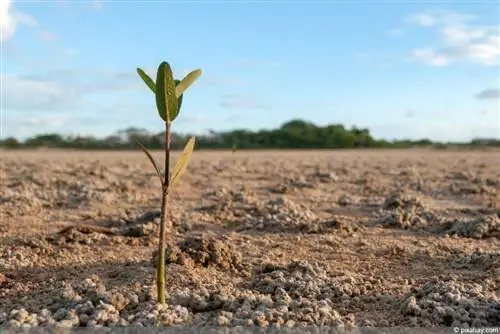
So that the mangrove tree does not die within a very short time, the following conditions should be met:
- Air temperature all year round between 25 and 30 °C
- Water temperature all year round at least 20 °C
- some species require between 24 and 26 °C
- Soil temperature all year round between 23 and 25 °C
- Humidity between 60 and 80 °C
- 10 to 12 hours of lighting daily
- artificial lighting absolutely necessary
- use special mangrove soil and fertilizer!
This information applies to all mangroves that can be cultivated in pots or aquariums.
Cultivating mangroves in pots
Given the required conditions, only a few enthusiasts will be able to cultivate their mangrove on the windowsill. In particular, the humidity and temperature will be difficult to maintain all year round.
Mangrove culture in the aquarium or terrarium
Therefore, culture in a more controllable freshwater or s altwater aquarium or tropical terrarium is recommended. The substrate should not be organic, but rather inorganic material such as sand or gravel. Mangroves maintained in this way also thrive in hydroponics.

